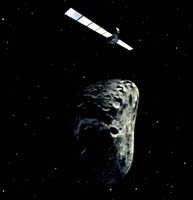On its way to the target comet in six years, Rosetta will pass by a small asteroid and test its instruments on it

Since emerging from a brief winter hibernation in early July, the Rosetta spacecraft has passed another milestone on its long journey to encounter comet Churyonov-Gramysenko in 2014. It began tracking asteroid 2867 Steins. The spacecraft will approach the asteroid on September 5, 2008 and spend the next month taking pictures and sending back science data.
Steins will remain a spot in the sky for the spacecraft for the near future, but these initial images will allow the spacecraft to gather more precise details about the asteroid's orbit, as well as its rotation period. Using optical and infrared cameras (OSIRIS) will allow it to image the asteroid twice a week until August 25th, then it will switch to daily imaging until the expected transit on September 5th. On that day, the spacecraft will approach the asteroid about 800 km, and photograph it at a relatively slow speed of 8.6 kilometers per second.
Steins' orbit has already been calculated using observations from the ground, but the images will help to optimize the trajectory and speed of the spacecraft. The asteroid's location is known with an accuracy of 100 kilometers, but Rosetta's images will help narrow the range of certainty to just 2 kilometers. "As the distance between Rosetta and the asteroid decreases, the accuracy of Stein's orbit measurements will increase even more, providing us with the largest velocity correction before the closest approach, especially in early September," said Sylvain Lodiut, of the Rosetta flight control team at the European Space Agency's Control Center.
During the approach flight to Steins, Rosetta will study its physical and chemical properties. It will also provide scientists with a detailed look at the properties of its motion - how fast it rotates, and how it reacts with the solar wind. When the Ruba spacecraft is in place for Stein, it will provide an opportunity to locate satellites of the asteroid if there are any, as well as gas and dust in its immediate vicinity.
Rosetta was launched in March 2004 and is now making a detour to reach its destination in 2014. It has passed by Earth twice – in March 2005 and February 2007 and another approach is planned for November 2009. The spacecraft used the approaches to provide spectacular images of the Earth at night using the Osiris camera. The illuminated areas are the inhabited areas of the Northern Hemisphere continents. Earth is not the only celestial body that Rosetta has visited, it passed within 1,000 kilometers of Mars in February 2007, and will make a close approach to asteroid 21 Lutetia in 2010. The planetary billiards game is designed to match the speed and direction of the spacecraft and the simulation of Earth, Mars and asteroids allows scientists to debug the scientific instruments on board the spacecraft.
When Rosetta reaches its target asteroid - Churyumov-Grasminenko, it will launch a lander known as Philae, which will dig into the comet's soil and reveal the nature of a comet for the first time. Rosetta itself will circle the comet and follow it on its journey around the Sun.

3 תגובות
What is the difference?
Decide an asteroid or a comet….
At the end it says comet, at the beginning asteroid...